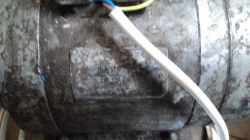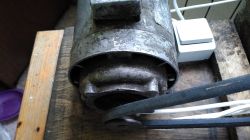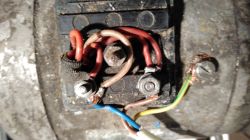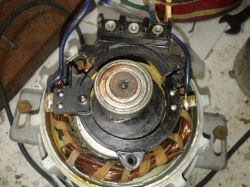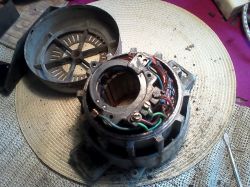FAQ
TL;DR: Frania motors are 180 W and ~1,380 rpm; "no starting capacitor—centrifugal switch inside." Humming signals a start-circuit issue. Inspect the centrifugal switch and protect the delicate start winding; avoid overloads that re-engage it. [Elektroda, LENIWIEC_PL, post #17601130]
Why it matters: This FAQ helps DIYers repurpose Frania motors for meat grinders, fix humming/no-start issues, and choose adequate power safely.
Quick Facts
- Typical Frania spec: 180 W output, ~1,380 rpm nominal speed. [Elektroda, LENIWIEC_PL, post #17601130]
- Start method: internal centrifugal switch; no external starting capacitor needed. [Elektroda, kierbedz4, post #17600582]
- Overload risk: speed drop re‑engages start winding; failure possible in approx. 6 minutes. [Elektroda, LENIWIEC_PL, post #17601130]
- For grinders, plan ≥500 W with reduction; example 700 W, 2,850 rpm, 1:25 reducer. [Elektroda, LENIWIEC_PL, post #17607043]
- 180 W can work slowly by using a large pulley on the grinder. [Elektroda, robokop, post #17607066]
Do I need a starting capacitor on a Frania washing machine motor?
No. The Frania motor uses an internal centrifugal start switch. “It did not need a starting capacitor because it has an internally mounted centrifugal start.” Keep the start winding intact and working. [Elektroda, LENIWIEC_PL, post #17601130]
Why does my Frania motor hum and only start if I spin it?
The start circuit is not engaging. Inspect the centrifugal switch contacts and mechanism. Verify the weights move the sleeve and switch plate. Measure start and run winding resistances with a meter. [Elektroda, Krzysztof Kamienski, post #17600489]
How do I fix a humming Frania motor?
Try this quick procedure:
- Remove the motor and access the starting device.
- Check the starting device resistance.
- Reinstall and test; confirm normal starting.
This restored normal operation for the original poster. [Elektroda, henio 123, post #17756054]
What are the typical specs of the older Frania motor?
Expect around 180 W and 1,380 rpm on these older units. Users reported multiple identical motors with those figures. [Elektroda, LENIWIEC_PL, post #17601130]
Is 180 W enough to power a meat grinder?
Not for comfortable grinding. Target at least 500 W with a reducer. One setup used 700 W at 2,850 rpm with a 1:25 gearbox and worked quickly. [Elektroda, LENIWIEC_PL, post #17607043]
Can I make a 180 W Frania grind meat at all?
Yes, if you slow the grinder with a large pulley. Expect slow throughput, but it will turn. [Elektroda, robokop, post #17607066]
Are belt transmissions safe for novice operators?
Belts can pose hazards. Prefer direct coupling with a dog clutch and angle gear for safer operation. [Elektroda, Staszek49, post #17601414]
How does the Frania’s start circuit work?
An internal centrifugal switch connects a start winding at low rpm. It opens the circuit once speed rises. “This motor has an internal centrifugal starter switch.” [Elektroda, Krzysztof Kamienski, post #17600489]
What happens if I overload the motor during grinding?
Speed falls under load. The centrifugal switch then re-engages the start winding. That winding is delicate and can fail in about six minutes. [Elektroda, LENIWIEC_PL, post #17601130]
Can I replace the centrifugal switch with an external starter?
Yes. Remove the internal switch and fit an external Kliston starter from chillers. Confirm the start coil works before doing this. [Elektroda, Krzysztof Kamienski, post #17600937]
How can I test the windings on this motor?
Measure resistance of the start and working windings with a multimeter. You should see distinct values. Replace or rewind if a winding is open. [Elektroda, Krzysztof Kamienski, post #17600489]
The motor now starts fine after service—am I done?
Likely yes. After removing, checking the starting device resistance, and reinstalling, the original poster reported normal operation. [Elektroda, henio 123, post #17756054]
Can I run the motor as-is if it needs a manual spin?
No. Repair the start system as advised. Running like that is unsafe and risks further damage. [Elektroda, atlantel, post #17600918]
